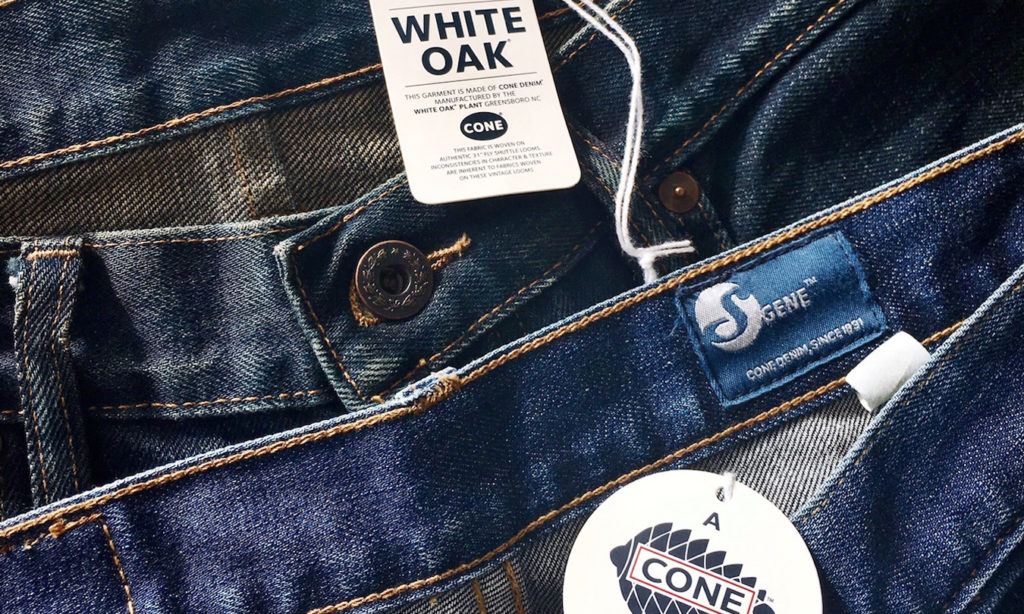
Denim Mills Want Consumers to Know Them Too
In today’s market, brand positioning is about more than just the brand—it’s also about the mills making the product.
Before transparency crept into the realm of apparel industry buzzwords and consumers began to care more about where their clothes came from, mills didn’t market directly to consumers or co-brand with brands as much as they do today.
Mills are increasingly being called out on hangtags, and brands like Madewell and Lucky Brand note mills where fabric came from on their e-commerce product pages.
For Cone Denim, a leading denim fabric supplier manufacturing in North Carolina, partnering with brands to highlight the features of their fabrics isn’t a new endeavor, but one that’s been rooted in its history from the time it introduced Cone Deeptone Denim in 1930. Over the years, through its branding and advertising, Cone has educated the consumer to expect quality from its fabrics. Now Madewell and Lucky Brand are among those marketing their use of Cone Denim.
“This technique for promoting our fabrics has carried through to this day to let the consumer know where the denim in their garments came from, whether it be our White Oak selvage, patented S Gene stretch and technical performance denim, or other genuine Cone Denim fabrics,” Kara Nichols, VP of product design and marketing at Cone Denim, said.
The fact that consumers are more interested in their products’ development cycle has been a boon for mills’ positioning.
“We think customers will be willing to understand and learn more about what they are using,” Umut Tahmaz, marketing manager at Turkey’s Kipas Denim said. “So having and promoting a strong brand will help us to penetrate the market more stable.”
With the glut of options consumers have when it comes to product today, Italian premium denim mill Candiani thinks the only way for them to decide where they’ll spend their money is to have more relevant knowledge of the product.
“Just think about how many products you compared the last time you had to purchase a juicer…that’s actually pretty easy compared to denim because you compare just technical data,” Candiani marketing manager Simon Giuliani said. “In denim you have different variables to take into consideration like craftsmanship, comfort, sustainability.”
Candiani’s branding is about giving the consumer that knowledge and reassuring them about the quality of the ingredients used in garments made with Candiani fabrics.
“We create a win-win situation for everyone involved: the brand can communicate with transparency the fabric as an added value, the consumer gets more knowledge about the product and can better evaluate his purchase, and the mill gains consumer awareness,” Giuliani said.
The notion is similar for Turkey’s ISKO. “We would like to educate the consumer that ISKO is in their most beloved jeans in order to generate demand for ‘powered by ISKO’ garments at the consumer level. This is a new B2C strategy for a denim mill and not an easy task at all since, as a fabric mill, we do not have direct contact with the consumers,” ISKO senior marketing executive Kutay Saritosun said. “Creating consumer-level awareness as an ingredient brand is a challenging task, however, once achieved, it is a very powerful tool to generate consumer demand for that ingredient.”
For true denim lovers, many take pride and peace of mind in knowing that they’re getting the real deal, Nicholas explained.
“With the wide array of brands to choose from in the market, we work with our customers to help them to differentiate their product and explain the benefits of the fabrics they are using—whether the end consumer is looking for authentic denim, superior stretch or technical performance properties,” Nicholas said.
The nature of the denim network has, in some ways, necessitated the need for the inclusion of mill marketing.
“The industry evolves around the needs, the expectations of the consumer on a global sense,” Ebru Debbağ, deputy general manager of Turkish denim mill Orta Anadolu, said. “The mills, the manufacturers, the laundries have an increasing urge to seek alternative production niches to take a stance in the making of jeans.”
As will always be the case, some consumers are more interested in where their denim comes from than others, but for those who are interested in the extra education about their purchases, access to that knowledge will be key for brands and mills alike to provide.
“I have been very curious about the food industry and the way it consumes and I think there is an increasing awareness in how/what we eat as well as what we put on our bodies,” Debbağ said. “Traceability is high on the consumers’ list. The brands have to stand out for more than just being cool—they have to present the social, environmental integration of their products.”
Seconding that sentiment, Tahmaz said social responsibility concerns are higher today than they ever have been.
“Consumer wants to know how it is made, and what is the effect of that product to our lives, future. It has recently started and will be more and more important each day,” he said.
From a brand perspective, Saritosun added, it’s also about created a story around the products through traceability to establish an emotional connection with the consumer.
Beyond sustainability, consumers are also very price-conscious, constantly seeking the best value for their money. Today, it’s to brands’ own benefit to promote the quality inclusions of their products, and teach the consumer to expect that standard from them.
“Working with brands who seek to promote the history of authenticity and ingenuity that has gone into the making of our denim by relaying this story to their end consumer who desires such a product has been a rewarding endeavor,” Nicholas said.
As Giuliani added, “Today brands are eager to show, to explain to their clients what they are buying and I, speaking as a consumer myself, believe that there is no other way to sell anymore.”






